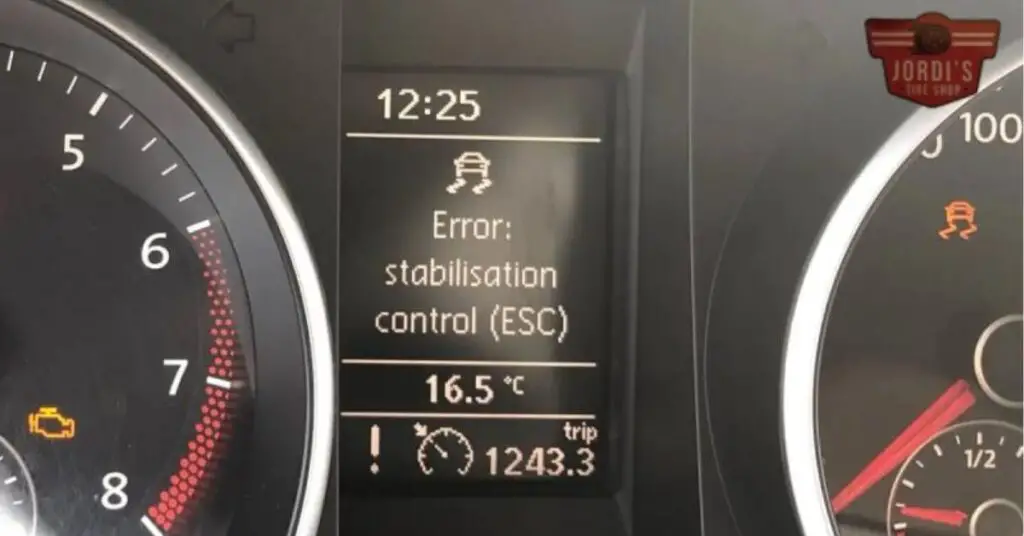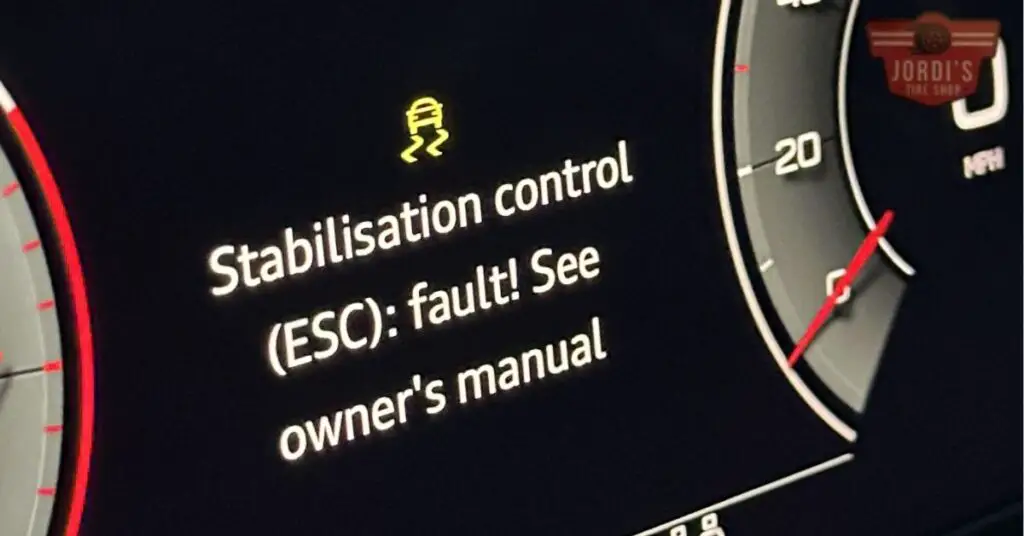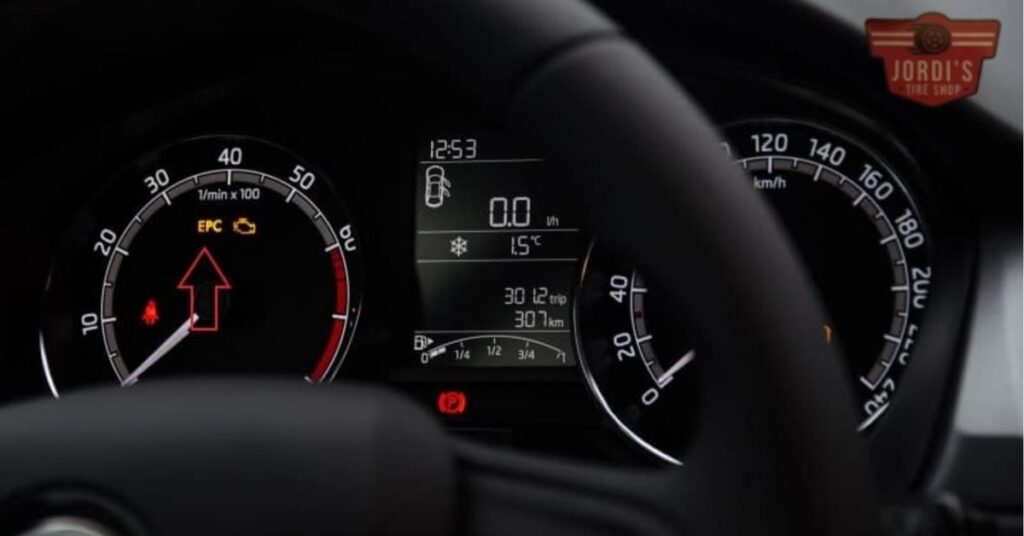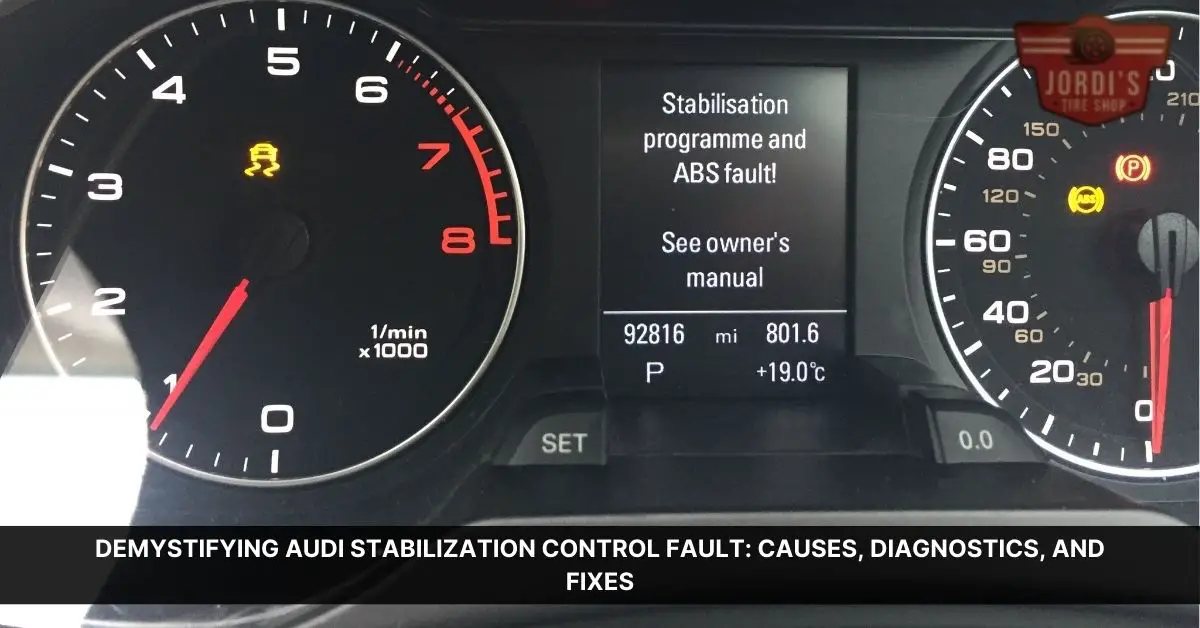You’re cruising down the highway in your Audi when suddenly, a warning light flashes on your dashboard – “stabilization control fault”. It’s a phrase that can send shivers down any car owner’s spine. But what does it really mean, and how serious is it?
Understanding Audi Stabilization Control Fault

As an Audi car owner, it’s essential to grasp the intricacies of stabilization control and its potential faults. Digging deeper, you’ll not only gain a better understanding but also be equipped to handle future occurrences.
What does Stabilization Control Mean in an Audi?
In your Audi, stabilization control, or Electronic Stability Control (ESC), refers to an advanced technological system. This system’s objective includes improving the vehicle’s stability by detecting and reducing instances of skidding. Essentially, when you lose steering control, ESC steps in, applying the brakes to individual wheels, which helps “steer” your vehicle. It’s important to know that this system checks for any inconsistencies and, if a fault is detected, sends a signal to illuminate a warning light on your dashboard.
Recognizing the Symptoms of a Fault
Spotting the signs of a fault in your vehicle’s stabilization control can aid in early detection and repair, maintaining optimum driving safety. The first sign that something’s off includes the lighting up of the warning light in your dashboard. You may also notice a decrease in your vehicle’s handling performance, with the car leaning more into turns or responding slower to steering. Another common symptom is the brake system captivating unpredictably, causing the vehicle to jerk or the brakes to pulse. It’s important to monitor these symptoms and seek professional assistance promptly if you suspect a fault in the stabilization control system.
Common Causes of an Audi Stabilization Control Fault
Uncertain what triggers an Audi stabilization control fault? Fret not, as we investigate into the root causes. It’s critical to remember they typically stem from faulty sensors or issues with the braking system.
Faulty Wheel Speed Sensors
Firstly, wheel speed sensors play a pivotal role in the Electronic Stability Control system. When defective, they can’t communicate crucial data about wheel speed to the system, leading to a “stabilization control fault” alert. For instance, road conditions like uneven surfaces or water puddles often cause these sensors to fail, often due to water intrusion, corrosion, or physical damage.
Damaged Steering Angle Sensors
Next, consider the role of steering angle sensors. They notify the ESC system of the steering wheel’s exact position, so controlling the vehicle’s direction. Damage to these sensors causes incorrect data transmission, triggering a fault. Popular causes of sensor impairment include steering system leaks, rusting, or a jolt from a collision.
Problems with the Braking System
Finally, the braking system directly impacts the efficiency of the ESC system. Issues such as worn-out brake pads, faulty brake calipers, or deteriorating brake fluid can hinder the performance of the ESC system. So, a stabilization control fault sign might show up on your Audi’s dashboard.
In all cases, it’s essential to seek professional assistance promptly after observing these signs. This ensures safe driving and prevents further possible damage.
Potential Dangers of an Audi Stabilization Control Fault

An Audi stabilization control fault can lead to dangerous consequences, affecting both the stability of your vehicle and the performance of your brakes.
Impact on Vehicle Stability
An error in the stabilization control system could disrupt your vehicle’s balance, resulting in unpredictable and potentially hazardous driving situations. For instance, faulty sensors disrupt communication between different parts of the car, causing disarray in the vehicle’s control system. If the stabilizer fault is due to a defect with the steering angle sensor, your Audi might send incorrect data about the steering wheel’s position. In turn, this can provoke sudden, uncontrolled car movements, especially when turning or driving on curvy roads. It’s crucial to note that stabilization faults can also be the result of conditions beyond your control, such as slippery roads, making it even more critical for the system to function optimally.
Effect on Brake Performance
Equally important is the impact on brake performance. The Electronic Stability Control system operates by manipulating brakes on individual wheels. A malfunction in this system could trigger uneven brake application, potentially causing your car to swerve dangerously. Similarly, brake-related causes of stabilization faults, such as worn-out brake pads or faulty brake calipers, can affect the vehicle’s stopping power. In extreme scenarios, the car might not respond when you step on the brake pedal, a truly perilous situation. Regular brake inspections and prompt fault fixes become a necessity to mitigate these risks and ensure a safer driving experience.
How to Diagnose an Audi Stabilization Control Fault

Moving on to diagnosing a stabilization control fault in an Audi, a pivotal step involves a thorough evaluation by professionals. Alongside this, understanding the common diagnostic tools utilized for Audis ensures better insight into the process.
Importance of Professional Diagnostics
Consider professional diagnostics an essential route for pinpointing and resolving Audi’s stabilization control fault. Experts possess the required skills to interpret the data relayed by the diagnostic tools. For instance, understanding the numeric codes generated by the tools, each referring to a exact problem, demands experience and technical knowledge.
Qualified professionals can differentiate between critical faults and minor glitches, aiding in addressing the real issue and preventing unnecessary repairs. Plus, they’re aware of the latest updates, recalls, and common weaknesses with exact models, offering specialized knowledge that could save time and money. Trusting Audi’s stabilization control fault diagnosis to those who know the vehicle inside and out ensures an accurate problem definition.
Common Diagnostic Tools for Audis
Familiarizing yourself with common diagnostic tools for Audis provides a better understanding of the situation. To start, there’s the On-Board Diagnostic II (OBD II) tool, a standardized system in most modern cars that detects a problem within a vehicle’s functional domain. Its vast code library enables it to communicate many potential issues accurately.
Audi also has a specialized scanning tool – the Virtual Dashboard System (VDS). VDS retrieves far more exact information than generic scanning tools, providing the unique advantage of reading Audi-exact fault codes.
Another competent tool is the VCDS (VAG-COM Diagnostic System). This software not only reads and clears Diagnostic Trouble Codes (DTCs) but also allows for carrying out many ‘dealer level’ operations, offering a comprehensive insight into Audi’s stabilization control fault.
Finally, there’s the Autel MaxiCOM MK808, designed to perform comprehensive diagnosing and reading for all systems in an Audi. Being a versatile tool, it offers additional features like service functions (oil reset, electronic parking brake release) and is, hence, widely used by professionals globally.
Taking a Audi to a professional who employs such advanced tools contributes immensely towards a thorough and accurate diagnosis, aiding in the vehicle’s swift recovery. Keep in mind that a deep understanding of these tools and their operation principles isn’t necessary; this lays in the capable hands of professionals. But, knowing their existence and purpose can enhance your command over the situation and decisions about your Audi’s health.
Fixing Audi Stabilization Control Faults
Addressing stabilization control faults in an Audi sounds daunting. But, not all fixes require a trip to the service center. The following explores possible fixes and when you should seek professional help.
DIY Fixes vs. Professional Repair
Do-it-yourself (DIY) fixes exist for some minor faults, including sensor issues or brake pad replacements. Let’s say, a faulty wheel sensor might be cleaned or replaced by a keen amateur. Brake pads, important in sending the right signals to the ESC system, might be swapped out with a little know-how and the right tools.
But, remember this before attempting repairs – especially in a system as critical as the ESC – without the right expertise, you may inadvertently cause more damage or compromise your vehicle’s safety. And that’s where professional repairs come in.
Professionals bring not only their expertise but also the correct tools and parts to the task. Often, they spot additional issues that might have been overlooked in a DIY approach. They may recognize, for example, that your brake pad issue stems from a larger fault with your braking system. In such instances, leaving it to the professionals ensures a comprehensive fix and a safe drive.
Timeline: When Should You Get It Repaired?
You might be wondering about the urgency of repairing an Audi stabilization control fault. With stabilization control having a direct influence on vehicle safety, it’s not an issue to be ignored or put on the back burner.
Upon noticing the warning lights or experiencing a decrease in handling performance, it’s time to act. If the problem seems minor and you feel confident, you can try implementing some DIY fixes immediately. But, if there’s no improvement or if you’re uncertain about the severity of the fault, don’t hesitate. Here’s a strategy – try a DIY solution the same day the symptom appears, use the vehicle carefully for a day, and if the indication is still on, seek professional help immediately.
Remember, safety is the absolute priority when it comes to vehicle repair, and addressing Audi stabilization control faults promptly ensures a smooth and safe ride.
Preventing Future Audi Stabilization Control Faults

Understand how frequent vehicle checks and timely maintenance play pivotal roles in preventing future issues related to your Audi’s stabilization control system. Your goal is to dodge the stress and dangers that come with a faulty ESC, and in achieving that, proactive care remains your best defense.
Regular Vehicle Checks
Make it a habit to conduct regular vehicle checks on your Audi. Your car’s stability depends heavily on the efficiency of its subsystems. Hence, consistency in monitoring the condition of various components becomes a necessity.
Note the state of wear and tear on your brake pads, it’s a crucial indicator of future ESC performance. Unhealthy brake pads hold potential for uneven brake application, one of the main culprits behind Audi stabilization control faults.
Keep a close eye on your wheel sensors, especially in harsh road conditions. These sensors act as the sensory organs of your ESC system, feeding it information about wheel speed. Damaged, dirty or faulty sensors fail to deliver accurate speed readings, putting the stabilization process at risk.
Check the steering angle sensors regularly. A timely discovery of damage in these sensors can prevent the transmission of incorrect data to the ESC system, so saving you from undesirable navigational errors.
Importance of Timely Maintenance
Scheduled maintenance forms the backbone of your car’s longevity and safe operation. Never postpone your regular maintenance appointments, even if you experience no immediate issues. Remember, ESC faults, like most car problems, are easier to prevent than to rectify, and cheaper too.
Ensure your brake system receives frequent inspections and necessary repairs. Don’t overlook the vitality of its role in maintaining vehicle stability, especially when turning or handling rough terrain.
Treat maintenance appointments as opportunities for comprehensive diagnostics. Make good use of professional tools like the OBD II and the VCDS. They provide priceless insights into your car’s health and help avoid future stabilization control faults.
Trust the service of professionals for addressing any issues that pop up during regular checks. If DIY repairs don’t bear fruit, don’t hesitate to consult experts. Their skills and tools can make all the difference in ensuring a seamless driving experience free from ESC faults.
Conclusion
So, it’s clear that an Audi stabilization control fault isn’t something you should ignore. This issue can affect your vehicle’s stability and brake performance, making it crucial to act promptly when you notice the warning signs. While some issues can be fixed with a bit of DIY, remember that professional help is often needed to ensure the fault is accurately diagnosed and properly rectified.
Keep your Audi in top shape by scheduling regular maintenance checks. Paying attention to the condition of your brake pads and wheel sensors can help prevent future faults. And remember, it’s always better to prevent these issues than to fix them.
With the right care and attention, you can keep your Audi running smoothly, ensuring a safe and seamless driving experience. Don’t let an Audi stabilization control fault put the brakes on your journey. Stay alert, act fast, and drive safe!
What is an Audi stabilization control fault?
An Audi stabilization control fault refers to a malfunction in the Electronic Stability Control (ESC) system. The ESC enhances the vehicle’s stability, and a fault could lead to decreased handling performance and unpredictable brake activity.
Why do Audi stabilization control faults occur?
Audi stabilization control faults typically occur due to faulty sensors or problems with the braking system. Faulty wheel speed sensors, steering angle sensors, or issues with brake pads or brake calipers can directly impact the ESC system’s efficiency.
How can an Audi stabilization control fault be diagnosed?
Professional diagnostic tools, such as the OBD II tool and the VCDS, are used to diagnose the Audi stabilization control fault. Qualified professionals can accurately interpret the diagnostic data and identify the underlying problem.
What can be done to fix this fault?
While minor issues can be resolved with DIY fixes, complex problems related to an Audi stabilization control fault require professional attention. Proper diagnosis and repairs by experts using professional tools is strongly recommended.
How can future Audi stabilization control faults be prevented?
Regular vehicle checks and timely maintenance are crucial in preventing future Audi stabilization control faults. Regular monitoring of brake pads, wheel sensors, and steering angle sensors condition is recommended. Consulting experts and using professional diagnostic tools can also ensure a seamless driving experience free from ESC faults.
Related Posts:
- FCW System Failure: Causes, Implications & How to Troubleshoot
- Understand and Combat ‘Steering Assist Reduced’: A Comprehensive Guide for Safer Driving
- Unlocking the Power of Service Driver Assist Systems: A Revolution in Auto Technology
- Mastering Audi Drive System Malfunctions: Causes, Diagnostics, and Solutions
- Decoding the ACC FCW Limited Functionality Warning: Crucial Insights for Safe Driving
- Decoding and Resolving the ‘ACC FCW Unavailable Service Required’ Warning in Your Jeep
- Mastering the Forward Emergency Braking Light in Your Nissan Rogue: A Safety Game-Changer
- Decoding the ‘Active Lane Management Unavailable – Service Required’ Alert: Your Guide to Safer Driving
- Demystifying Audi Stabilization Control Fault: Causes, Diagnostics, and Fixes
- Troubleshooting the ‘Engine Power is Reduced’ Warning in Your Chevy Cruze: Causes and Fixes

